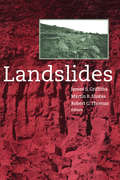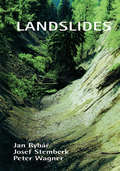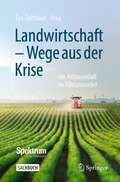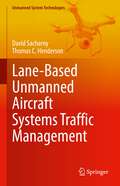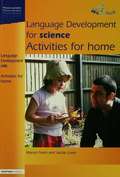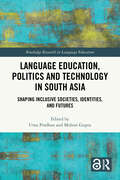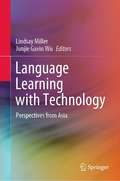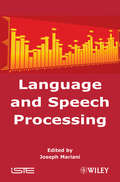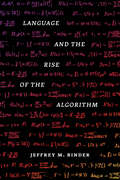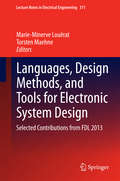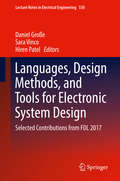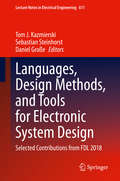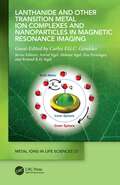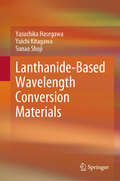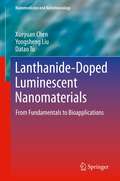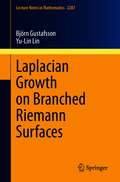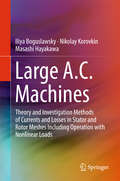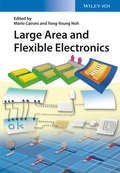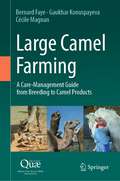- Table View
- List View
Landslides: Proceedings of the 9th international conference and field trip, Bristol, 16 September 1999
by James S. Griffiths Martin R. Stokes Robert G. ThomasThis text gives an overview of the main landslide field sites. It covers aspects of recent landslide research at the University of Wollongong.Topics: An overview of the main landslide field sites in the 9th ICFL; Aspects of recent landslide research at the University of Wollongong; Infiltration of rainwater and slope failure; Landslide hazards and highway engineering in Central and Northern Jordan; El Niño 1997-98: Direct costs of damaging landslides in the San Francisco Bay region; Mass movement features in the vincinity of the town Sorbas, South-east Spain; The movements and the countermeasures of the Choja Landslide; Interest in landslide hazard information - Parallels between Kingston, Jamaica and the San Francisco Bay region, USA; Slide activity in quick clay related to pore water pressure and weather parameters; Old and recent landslides of Barranco de Tirajana basin, Gran Canaria, Spain.
Landslides: Proceedings of the First European Conference on Landslides, Prague, Czech Republic, 24-26 June 2002
by Peter Wagner Jan Rybář Josef StemberkThe proceedings contain five invited lectures and 99 papers relevant to landslide occurrence and problems from Europe, Asia, America, Africa and Australia and New Zealand. The five special invited lectures deal with a variety of important aspects of landslides.
Landwirtschaft - Wege aus der Krise: von Artenvielfalt bis Klimawandel
by Eva GottfriedLandwirtschaft geht uns alle an!Mit immer ertragreicheren Sorten, modernen Düngemitteln und potenten Pestiziden haben wir jahrelang eine intensivierte Landwirtschaft auf Kosten der Natur vorangetrieben. Nun schielen immer mehr Landwirte auf naturnahe, nachhaltige Ansätze. Doch was bedeutet dies für die Agrarwirtschaft? Sind an den Klimawandel angepasste Kulturpflanzen nachhaltig? Und sollen wir diese durch klassische, langwierige Züchtung entwickeln oder ist grüne Gentechnik durch Schnelligkeit im Vorteil? Wie steht es um Patente auf Naturprodukte? Können wir die Agrarwirtschaft in unsere immer größeren Städte integrieren und vielleicht durch Digitalisierung retten? Die im Buch gesammelten Beiträge aus Spektrum der Wissenschaft, Spektrum – die Woche und Spektrum.de bieten vielfältige Ansätze und Denkanstöße mit Blick auf Herausforderungen, Risiken und Möglichkeiten für ein Umlenken in der Landwirtschaft.
Lane-Based Unmanned Aircraft Systems Traffic Management (Unmanned System Technologies)
by Thomas C. Henderson David SacharnyThe age of Advanced Air Mobility (AAM) is upon us, and in ushering new ways to connect and travel, this wave of technology has been compared to GPS and cloud computing. However, new technologies like AAM require tools to build, expand, and understand the capabilities. This book describes an effective and efficient, complete solution to the large-scale, unmanned aircraft systems (UAS) traffic management problem. The authors present a detailed perspective and solutions to some of the major problems involved in coordinating thousands of autonomous vehicles including: virtual highway (lane) creation, strategic deconfliction of flights, dynamic deconfliction, UAS agent behavior learning, anomalous trajectory detection and classification, as well as a set of simulation results for a variety of scenarios (city package delivery, earthquake supply delivery, coalition force coordination through the lane reservation system, etc.).
Language Development for Science: Activities for Home
by Marion Nash Jackie LoweThese simple play-based activities are ideal for teachers to copy and give out to parents who want to know how to help their child improve his or her science language skills and have fun at the same time. Activities are linked directly to the school-based Language Development Circle Time sessions, but can also be used independently. There is a clear structure and progression of ideas, with supporting black-line drawings to acts as prompts and simple record - keeping system to support home/school communication.
Language Development for Science: Circle Time Sessions to Improve Language Skills
by Marion Nash Jackie LoweThis book is the first of its kind to help practitioners specifically develop children's language skills in Science. The book incudes: guidelines to help teachers set up, run and assess circle-time sessions ideas for promoting children's thinking skills and emotional literacy video CD containing explanation and demonstration of the programme and its implementation, with comments from staff who have used it.
Language Education in Digital Spaces: Perspectives on Autonomy and Interaction (Educational Linguistics #52)
by Carolin Fuchs Mirjam Hauck Melinda DoolyThis book brings together contributions on learner autonomy from a myriad of contexts to advance our understanding of what autonomous language learning looks like with digital tools, and how this understanding is shaped by and can shape different socio-institutional, curricular, and instructional support. To this end, the individual contributions in the book highlight practice-oriented, empirically-based research on technology-mediated learner autonomy and its pedagogical implications. They address how technology can support learner autonomy as process by leveraging the affordances available in social media, virtual exchange, self-access, or learning in the wild (Hutchins, 1995). The rapid evolution and adoption of technology in all aspects of our lives has pushed issues related to learner and teacher autonomy centre stage in the language education landscape. This book tackles emergent challenges from different perspectives and diverse learning ecologies with a focus on social and educational (in)equality. Specifically, to this effect, the chapters consider digital affordances of virtual exchange, gaming, and apps in technology-mediated language learning and teaching ranging from instructed and semi-instructed to self-instructed contexts. The volume foregrounds the concepts of critical digital literacy and social justice in relation to language learner and teacher autonomy and illustrates how this approach may contribute to institutional objectives for equality, diversity and inclusion in higher education around the world and will be useful for researchers and teachers alike.
Language Education, Politics and Technology in South Asia: Shaping Inclusive Societies, Identities, and Futures (Routledge Research in Language Education)
by Uma Pradhan Mohini GuptaBringing together research from the fields of linguistics, education and technology within the dynamic context of South Asia, this timely book investigates the ways in which these fields interact with each other against the backdrop of technological innovation, linguistic diversity and socio-political transformation.Developing and expanding on findings and insights originating from a conference organised by the Education South Asia Initiative at the University of Oxford, this interdisciplinary book features academic reflections on language politics and diversity as well as empirical insights on linguistic, educational and technological transformations in the region. Featuring analytical and methodological approaches to the study of language and education, chapters range in context from India, Bangladesh, Nepal, Pakistan and Sri Lanka, and address a range of issues such as the marginalisation of languages in education and policy, the interactions between language and social hierarchies in the South Asian context, and technology’s impact on language education, acquisition, usage and preservation.Ultimately initiating dialogue on the need for positive changes in language, education research and policy, this book will appeal to scholars, researchers and postgraduate students in the fields of language education, international and comparative education, and education and technology. Policymakers in international development and sociolinguistics may also find the volume of use.The Open Access version of this book, available at http://www.taylorfrancis.com, has been made available under a Creative Commons Attribution-Non Commercial-No Derivatives (CC BY-NC-ND) 4.0 license.
Language Learning with Technology: Perspectives from Asia
by Lindsay Miller Junjie Gavin WuThis book is about language learning with technology, offering readers theoretical insights as well as practical case studies with a focus on Asia and Asian students. Although technology is rapidly advancing and most, if not all, students are already using technology in their everyday lives, traditional teaching/learning practices still exist throughout Asia. This book provides examples, written by representative educators, from a variety of countries/regions and contexts where technology has successfully been used to enhance language learning. In addition to some everyday examples of using technology: Wikipedia, PowerPoint, Google Docs and YouTube, the book also offers the readers an insight into the future possible uses of advanced technology: Augmented Reality, Virtual Reality, Artificial Intelligence and Eye Tracking. The book presents illustrations of how teachers can, and perhaps should, be open to integrating some form of technology into in-class learning or using it to supplement out-of-class activities.
Language and Literacy in Inquiry-Based Science Classrooms, Grades 3-8
by Zhihui Fang Linda L. Lamme Rose M. PringleThis hands-on resource offers a wealth of strategies aligned with national science education standards, including sample lessons for integrating reading instruction into inquiry-based science classrooms.
Language and Speech Processing
by Joseph MarianiSpeech processing addresses various scientific and technological areas. It includes speech analysis and variable rate coding, in order to store or transmit speech. It also covers speech synthesis, especially from text, speech recognition, including speaker and language identification, and spoken language understanding. This book covers the following topics: how to realize speech production and perception systems, how to synthesize and understand speech using state-of-the-art methods in signal processing, pattern recognition, stochastic modelling computational linguistics and human factor studies.
Language and the Rise of the Algorithm
by Jeffrey M. BinderA wide-ranging history of the algorithm. Bringing together the histories of mathematics, computer science, and linguistic thought, Language and the Rise of the Algorithm reveals how recent developments in artificial intelligence are reopening an issue that troubled mathematicians well before the computer age: How do you draw the line between computational rules and the complexities of making systems comprehensible to people? By attending to this question, we come to see that the modern idea of the algorithm is implicated in a long history of attempts to maintain a disciplinary boundary separating technical knowledge from the languages people speak day to day. Here Jeffrey M. Binder offers a compelling tour of four visions of universal computation that addressed this issue in very different ways: G. W. Leibniz’s calculus ratiocinator; a universal algebra scheme Nicolas de Condorcet designed during the French Revolution; George Boole’s nineteenth-century logic system; and the early programming language ALGOL, short for algorithmic language. These episodes show that symbolic computation has repeatedly become entangled in debates about the nature of communication. Machine learning, in its increasing dependence on words, erodes the line between technical and everyday language, revealing the urgent stakes underlying this boundary. The idea of the algorithm is a levee holding back the social complexity of language, and it is about to break. This book is about the flood that inspired its construction.
Languages, Design Methods, and Tools for Electronic System Design
by Marie-Minerve Louërat Torsten MaehneThis book brings together a selection of the best papers from the sixteenth edition of the Forum on specification and Design Languages Conference (FDL), which was held in September 2013 in Paris, France. FDL is a well-established international forum devoted to dissemination of research results, practical experiences and new ideas in the application of specification, design and verification languages to the design, modeling and verification of integrated circuits, complex hardware/software embedded systems and mixed-technology systems.
Languages, Design Methods, and Tools for Electronic System Design: Selected Contributions from FDL 2017 (Lecture Notes in Electrical Engineering #530)
by Daniel Große Sara Vinco Hiren PatelThis book brings together a selection of the best papers from the twentiethedition of the Forum on specification and Design Languages Conference (FDL), which took place on September 18-20, 2017, in Verona, Italy. FDL is a well-established international forum devoted to dissemination of research results, practical experiences and new ideas in the application of specification, design and verification languages to the design, modeling and verification of integrated circuits, complex hardware/software embedded systems, and mixed-technology systems.Covers modeling and verification methodologies targeting digital and analog systems;Addresses firmware development and validation;Targets both functional and non-functional properties;Includes descriptions of methods for reliable system design.
Languages, Design Methods, and Tools for Electronic System Design: Selected Contributions from FDL 2018 (Lecture Notes in Electrical Engineering #611)
by Daniel Große Tom J. Kazmierski Sebastian SteinhorstThis book brings together a selection of the best papers from the twenty-first edition of the Forum on specification and Design Languages Conference (FDL), which took place on September 10-12, 2018, in Munich, Germany. FDL is a well-established international forum devoted to dissemination of research results, practical experiences and new ideas in the application of specification, design and verification languages to the design, modeling and verification of integrated circuits, complex hardware/software embedded systems, and mixed-technology systems.Covers Assertion Based Design, Verification & Debug;Includes language-based modeling and design techniques for embedded systems;Covers design, modeling and verification of mixed physical domain and mixed signal systems that include significant analog parts in electrical and non-electrical domains;Includes formal and semi-formal system level design methods for complex embedded systems based on the Unified Modelling Language (UML) and Model Driven Engineering (MDE).
Lanthanide Luminescence
by Pekka Hänninen Harri HärmäLanthanides have fascinated scientists for more than two centuries now, and since efficient separation techniques were established roughly 50 years ago, they have increasingly found their way into industrial exploitation and our everyday lives. Numerous applications are based on their unique luminescent properties, which are highlighted in this volume. It presents established knowledge about the photophysical basics, relevant lanthanide probes or materials, and describes instrumentation-related aspects including chemical and physical sensors. The uses of lanthanides in bioanalysis and medicine are outlined, such as assays for in vitro diagnostics and research. All chapters were compiled by renowned scientists with a broad audience in mind, providing both beginners in the field and advanced researchers with comprehensive information on on the given subject.
Lanthanide and Other Transition Metal Ion Complexes and Nanoparticles in Magnetic Resonance Imaging (ISSN)
by Geraldes, Carlos F. G. C.Since the development of the first clinical MRI contrast agent, Gd(DTPA) (or Magnevist®) in the early 1980s, another three linear and three macrocyclic (eg. Gd(DOTA) (Dotarem®) have been introduced in the clinic and inspired a huge number of researchers worldwide to perform preclinical research to obtain contrast agents for many kinds of clinical applications, which are described in this book. The most current research has been assembled here and can be used by the scientific community to continue increasing the relevance of metal-containing molecules and nanomaterials for MRI-based diagnosis and thus increase the practical use of these systems. Presents the importance of metal-containing molecules and nanomaterials for MRI-based diagnosis and the practical use of these systems. Discusses the structure and dynamics of Ln-based contrast agents as well as computational studies related to these agents. Endorses and stimulates research in the vibrant field of biological inorganic chemistry. Reviews the most current research supporting the relevance of metal-containing molecules and nanomaterials for diagnosis and therapy. The authors are preeminent bioinorganic and medicinal inorganic chemists and review the most current research in this field.
Lanthanide-Based Wavelength Conversion Materials
by Yasuchika Hasegawa Yuichi Kitagawa Sunao ShojiThis book introduces optical wavelength conversion materials using luminescent lanthanide complexes. Their optical wavelength conversion properties are applied to color-tuning LED materials, UV photon-energy conversion for solar cells, and plant growth acceleration for future green-house application. In this book, the fundamental wavelength-conversion mechanism, recent trends and advanced research progress of optical wavelength conversion materials are explained and discussed using historical and recent academic reports. Furthermore, advanced future applications using luminescent lanthanide complexes, are introduced.
Lanthanide-Doped Luminescent Nanomaterials
by Xueyuan Chen Yongsheng Liu Datao TuLanthanide-Doped Luminescent Nanomaterials reviews the latest advances in the development of lanthanide-doped luminescent inorganic nanoparticles for potential bioapplications. This book covers the chemical and physical fundamentals of these nanoparticles, such as the controlled synthesis methodology, surface modification chemistry, optical physics, and their promising applications in diverse bioassays, with an emphasis on heterogeneous and homogeneous in-vitro biodetection of tumor biomarkers. This book is intended for those readers who are interested in systematically understanding the materials design strategy, optical behavior of lanthanide ions, and practical bioapplications of lanthanide nanoparticles. It primarily focuses on the interdisciplinary frontiers in chemistry, physics and biological aspects of luminescent nanomaterials. All chapters were written by scientists active in this field and for a broad audience, providing both beginners and advanced researchers with comprehensive information on the subject. Xueyuan Chen is a Professor at Fujian Institute of Research on the Structure of Matter (FJIRSM), Chinese Academy of Sciences. Yongsheng Liu is a Research Associate Professor at FJIRSM, Chinese Academy of Sciences. Datao Tu is a Research Assistant Professor at FJIRSM, Chinese Academy of Sciences.
Laparo-endoskopische Hernienchirurgie: Evidenzbasierte Klinische Praxis
by Karl A. LeBlanc Reinhard Bittner Ferdinand Köckerling Robert J. Fitzgibbons Sumeet Mittal Pradeep ChowbeyDiagnostik und laparoskopische Therapie von Leistenhernien, Bauchwand- und Narbenhernien sowie Hiatushernien werden Schritt für Schritt und mit zahlreichen Abbildungen von einem internationalen Expertenteam beschrieben. Neben den etablierten Verfahren sind auch neu entwickelte Operationstechniken und das Vorgehen bei atypischen und komplexen Hernienformen dargestellt, ebenso die Prävention und Behandlung von Komplikationen. Der Netztechnologie ist zu jedem der Hauptthemen ein eigenes Kapitel gewidmet. Vor- und Nachteile der einzelnen Behandlungsformen werden diskutiert und verglichen. Jedes Kapitel nimmt dabei Bezug auf die anerkannten Leitlinien der Fachgesellschaften und die relevanten Studien, Übersichten und Metaanalysen und bezieht zugleich die Erfahrungen und Empfehlungen renommierter Hernienchirurgen ein. Standardisierte Operationstechnik und evidenzbasierte Entscheidungsfindung tragen zur Verbesserung der Behandlungsergebnisse in der laparo-endoskopischen Hernienchirurgie bei.
Laplace-Transformation, Diskrete Fourier-Transformation und z-Transformation: Grundlagen und Anwendungen zu Elektrotechnik, Informatik, Kommunikations- und Regelungstechnik
by Helmut Ulrich Stephan UlrichDieses Buch ist eine leicht verständliche Einführung in die Theorie und praktische Handhabung der Laplace-, Fourier- und z-Transformation, die in vielen Fachgebieten wie der Elektrotechnik , Informations- und Kommunikationstechnik, Mechatronik, Regelungstechnik etc. eine wichtige Rolle spielen. Zahlreiche Beispiele und Anwendungen zeigen den richtigen Umgang mit den Transformationen. Die Erläuterungen werden vielfach durch graphische Darstellungen veranschaulicht. Das Ziel des Buches ist es, eigene Problemstellungen mit den gezeigten Methoden erfolgreich angehen zu können. Die didaktische Aufbereitung des Lehrstoffes im Buch sichert einen nachhaltigen Lernerfolg .
Laplacian Growth on Branched Riemann Surfaces (Lecture Notes in Mathematics #2287)
by Björn Gustafsson Yu-Lin LinThis book studies solutions of the Polubarinova–Galin and Löwner–Kufarev equations, which describe the evolution of a viscous fluid (Hele-Shaw) blob, after the time when these solutions have lost their physical meaning due to loss of univalence of the mapping function involved. When the mapping function is no longer locally univalent interesting phase transitions take place, leading to structural changes in the data of the solution, for example new zeros and poles in the case of rational maps. This topic intersects with several areas, including mathematical physics, potential theory and complex analysis. The text will be valuable to researchers and doctoral students interested in fluid dynamics, integrable systems, and conformal field theory.
Large A.C. Machines
by Masashi Hayakawa Iliya Boguslawsky Nikolay KorovkinIn this monograph the authors solve the modern scientific problems connected with A. C. motors and generators, based first on the detailed consideration of their physical phenomena. The authors describe the theory and investigative methods they developed and applied in practice, which are considered to be of essential interest for specialists in the field of the electrical engineering industry in European countries, the USA, Argentina, and Brazil, as well as in such countries as India, China, and Iran. This book will be of interest to engineers specialized in the field of the manufacture, operation, and repair of A. C. machines (motors and generators) as well as electric drives; to professors, lecturers, and post-graduate students of technical universities, who are specializing in the field of electric machine engineering and electric drives; and to students who are engaged in the field of high current techniques, electric drives, and electric machine engineering.
Large Area and Flexible Electronics
by Yong-Young Noh Mario CaironiFrom materials to applications, this ready reference covers the entire value chain from fundamentals via processing right up to devices, presenting different approaches to large-area electronics, thus enabling readers to compare materials, properties and performance.Divided into two parts, the first focuses on the materials used for the electronic functionality, covering organic and inorganic semiconductors, including vacuum and solution-processed metal-oxide semiconductors, nanomembranes and nanocrystals, as well as conductors and insulators. The second part reviews the devices and applications of large-area electronics, including flexible and ultra-high-resolution displays, light-emitting transistors, organic and inorganic photovoltaics, large-area imagers and sensors, non-volatile memories and radio-frequency identification tags.With its academic and industrial viewpoints, this volume provides in-depth knowledge for experienced researchers while also serving as a first-stop resource for those entering the field.
Large Camel Farming: A Care-Management Guide from Breeding to Camel Products
by Bernard Faye Gaukhar Konuspayeva Cécile MagnanThis practical guide is intended for all actors in the sector who work with large camelids, whether in breeding, technical advice or veterinary care. It successively describes the general aspects of the species, the physiological bases of reproduction, lactation and feeding, the main production processes, and health and hygiene management in camel breeding. Chapters on slaughter, important camel products and their processing complete the volume.Large camels (camels and Bactrian camels) are domestic animals that are increasingly used in Western countries, as well as in Africa and Asia, for tourism, sport, and production of milk, meat, and wool. In addition, camel husbandry systems are changing, taking a greater share of sedentary systems, specializing in breeding, and intensifying production. At the same time, many veterinarians and breeders are not familiar with the animal, its needs, physiology, diseases, and management, which is often based on practices introduced for cattle and proving ineffective.This work is a practical aid for all interested readers who want to embark on the adventure of working with large camelids in a cultural context where they are not yet a dominant element of the agricultural landscape. The numerous photographs and drawings that support the text make it a unique and entertaining read.
